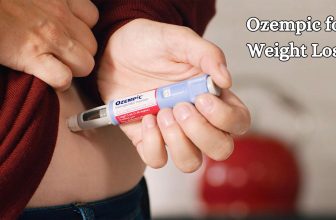How to Measure Your Body for Weight Loss? A Comprehensive Guide

When it comes to weight loss, one of the most important things you can do is measure your progress. This may seem like a daunting task, but it’s really not as difficult as you might think. In this article, we will walk you through how to measure your body for weight loss? We’ll cover everything from BMI to waist-to-hip ratio, so you can be sure that you are doing everything possible to achieve your goals.
If you’re like most people, you’d like to lose weight. But you don’t know if you’re at a healthy weight, and the best way to go about losing weight is. Then, this comprehensive guide will teach you everything you need to know about measuring your body for weight loss. You’ll learn about waist circumference and other ways to measure progress. Plus, we’ll provide tips for losing weight safely and effectively. So read on for all the info!
What Factors Do You Need to Consider When Measuring Your Body for Weight Loss Success?
The factors you need to consider when measuring your body for weight loss success are your weight, height, age, and sex.
Your weight is the most important factor to consider when trying to lose weight. You can use a variety of methods to measure your weight, but the most common is BMI (body mass index). BMI is a number that compares your height and weight. It’s not perfect, but it’s a good way to get an idea of whether you’re at a healthy weight.
To calculate your BMI, you’ll need to know your height in inches and your weight in pounds. Once you have that information, you can plug it into this BMI calculator. A BMI of 18.0-24.99 is considered healthy; 25.0-29.99 is considered overweight; 30.0 and above is considered obese.
Your height is also an important factor to consider when trying to lose weight. If you’re very tall, you may need to lose more weight than someone who’s shorter than you to achieve a healthy BMI.
Age and sex are also factors that can affect how much weight you should lose. For example, older adults may need to lose less weight than younger adults to achieve a healthy BMI. And women generally need to lose less weight than men to achieve a healthy BMI.
Keep in mind that these are general guidelines. Everyone’s body is different.!
How to Measure Your Body for Weight Loss? – Measure Yourself
To get an accurate idea of how much weight you’ve lost, it’s important to take your measurements at least twice and record them in this progress chart every four weeks. You can also use a flexible cloth or paper measuring tape for more precision when taking body fat readings from different areas on the body—like underarms (or other private parts), waistline + hips+ upper arms span. The MyoTape measures are made specifically
To help people with their fitness goals by allowing them to measure distances ranging up to 10 inches; giving options that suit all shapes & sizes!
How Do You Measure Your Waist, Hips, And Thighs Correctly for The Most Accurate Results Possible?
For an accurate measurement of your waist, stand with your feet together and measure around the narrowest part of your waistline, generally just above your belly button. For women, it’s important to also measure the hips at the widest point, which is typically about eight inches below the natural waistline. To get an accurate measurement of your thighs, simply measure around the fullest part of each thigh.
When measuring your body for weight loss, be sure to:
- Use a flexible tape measure or paper measuring tape
- Stand with your feet together
- Measure around the narrowest part of your waistline (just above the belly button)
- Measure around the fullest part of each thigh
What Tools and Equipment Will You Need to Measure Your Progress Along the Way (E.G., Scales, Measuring Tape)?
If you’re serious about losing weight, you’ll need to invest in a good quality scale and measuring tape. Scales can vary significantly in inaccuracy, so it’s important to find one that you trust. A measuring tape is relatively inexpensive, but it’s an essential tool for tracking your progress.
You may also want to consider investing in a body fat caliper. This tool measures the percentage of fat vs. muscle in your body, which can give you a more accurate picture of your progress than simply relying on weight alone. However, body fat calipers are not necessary for everyone – if you don’t feel comfortable using one, don’t worry! There are plenty of other ways to track your progress (more on that below).
How Often Should You Measure Your Body to Track Your Weight-Loss Journey Accurately and Effectively?
It depends on how quickly you’re losing weight and how much variation you’re seeing from week to week. In general, though, we recommend measuring your body once per week – any more than that, and you may start to obsess over small changes that might not be meaningful in the long run. On the other hand, if you’re not seeing any progress after a few weeks of dieting and exercise, it might be worth measuring your body more frequently to see what’s going on. The bottom line is: find a frequency that works for you and stick with it!
There are a few different ways to measure your body for weight loss. The most common method is simply stepping on a scale, but this only tells you your overall weight – it doesn’t give you any information about how much of that weight is fat, muscle, or water. If you’re looking to lose fat specifically, you’ll want to use a different method.
One popular way to measure body fat percentage is through skinfold calipers. This involves pinching different parts of your body (usually the stomach, chest, and thighs) and measuring the thickness of the skin and underlying layer of fat. You can then input these measurements into a formula to calculate your body fat percentage. While skinfold calipers are relatively affordable and easy to use, they are not always accurate – especially if you don’t know how to properly use them.
What Are Some Tips for Staying Motivated During the Measurement Process?
It can be tough to stay motivated when you’re trying to lose weight and track your progress. Here are a few tips that may help:
- Find a friend or family member who is also interested in weight loss and measuring their body fat percentage. You can support each other and stay on track together.
- Set small, achievable goals for yourself. For example, aim to lose one pound per week or reduce your body fat percentage by one percent every month.
- Keep a journal of your progress. Write down how you’re feeling, what measurements you’re taking, and how much weight you’ve lost (or how many inches you’ve lost from your waist). This will help you see how far you’ve come and how much progress you’ve made.
- Remember that weight loss is not a linear process. There will be ups and downs along the way. Don’t get discouraged if you have a week where you don’t lose any weight or you gain a few pounds back. Just keep tracking your progress and stay on track with your goals.
If you’re serious about losing weight, then it’s important to measure your body fat percentage. This will give you an accurate idea of how much fat you need to lose and how much muscle you need to gain.
How Can You Celebrate Small Victories Along the Way as You Work Towards Your Ultimate Goal?
One way to stay motivated throughout your weight loss journey is to celebrate small victories along the way. This could mean setting a goal to lose X pounds in a certain timeframe and then rewarding yourself with a new outfit or piece of jewelry once you reach that goal. Or, it could simply be taking some time out for yourself to relax and enjoy a spa day after losing X pounds. Whatever makes you feel good and keeps you moving forward is what counts!
A Word from Very Well!
So, hope you get your real answer to “how to measure your body for weight loss?” With the comprehensive guide, we’ve outlined in this post. Whether you’re trying to lose a few pounds or a hundred, using the right metrics is essential to seeing results. Weigh yourself regularly, track your progress over time, and find what works best for you. However, armed with the right information and a little bit of know-how, you can accurately determine your starting point and track your progress along the way.
Source Links:
https://www.kim-pearson.com/advice/tracking-weight-loss-how-to-measure-yourself/
https://www.verywellfit.com/how-to-take-your-body-measurements-1231126





